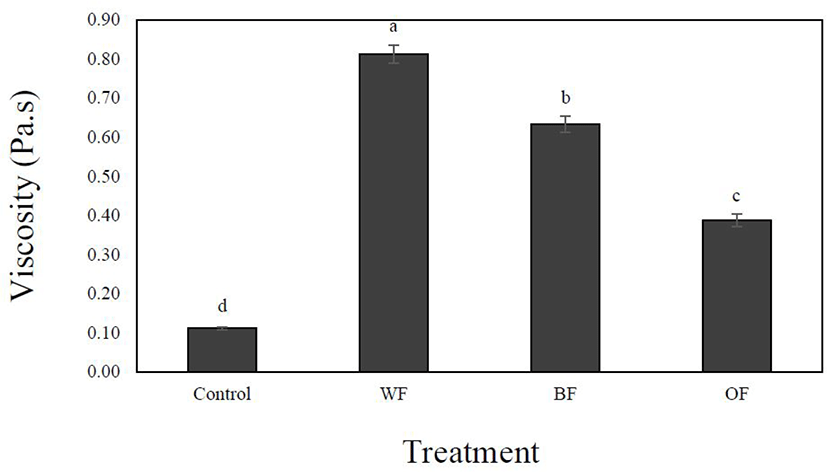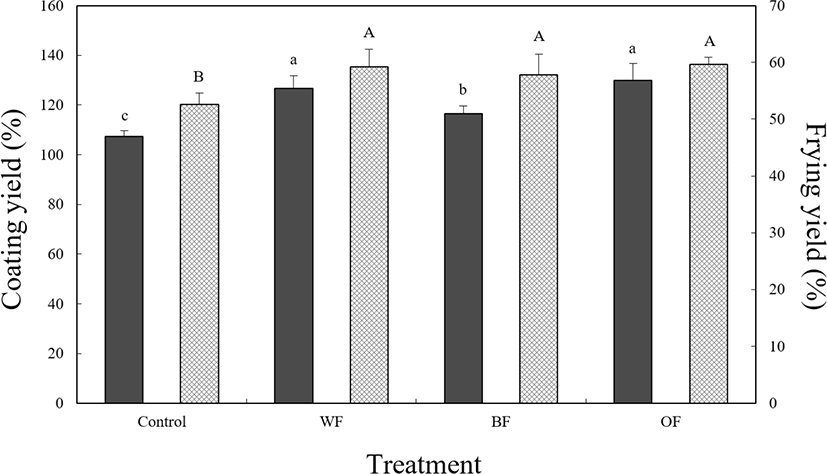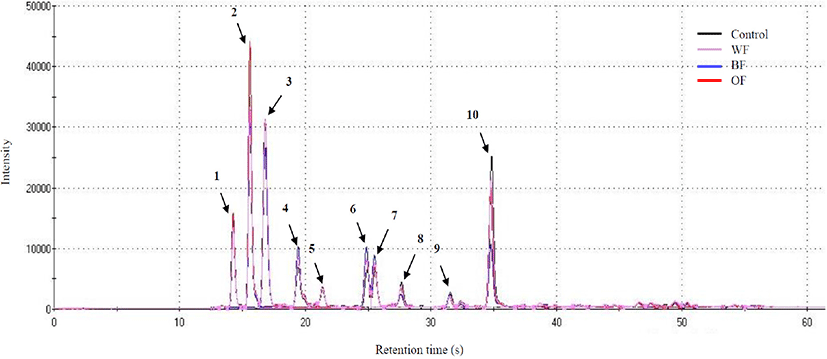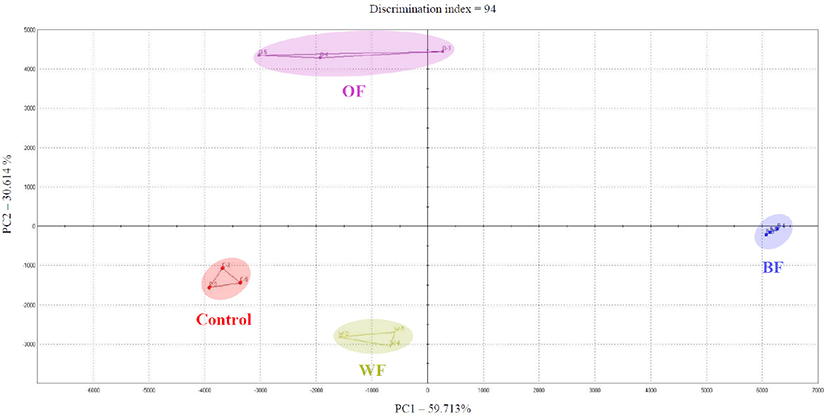INTRODUCTION
Current trends in the supply and demand of animal-based products, including meat-based products, have been steadily increasing and this has also lead to an increase in public health concerns regarding meat or meat-based product consumption [1]. Concerns over edible oils and fats contained in meat-based products that have undergone the deep-fat frying processes are especially high [2], and such dishes are publicly perceived as one of the culprits of high blood pressure and obesity in adults [3,4].
Deep-fat frying requires submerging ingredients in edible oils and fats, typically heated to 140°C–190°C, for several minutes depending on the ingredients used and the recipe. This process traps moisture and absorb oils to enhance the flavor [5]. The most commonly used method is to coat batter on the surface of a piece of meat base before frying in oil [4]. The batter quickly solidifies from its original fluid consistency, becoming a protective coat holding the moisture and flavor of the base ingredient while allowing oil to be better absorbed to enhance the flavor [6]. However, this process raises trans-fat content excessively leading to higher health risks in adults [7,8]. Therefore, there is an urgent need for fried-food development and production that takes into consideration and supports consumer health.
Dietary fibers, also known as fiber or cellulose, do not undergo digestion in the human digestive system and are excreted from the body as carbohydrate macromolecules [9]. When ingested through edible means, dietary fibers can absorb water and toxins effectively from the gastrointestinal tract and protect the organs from damage through absorption of the trapped toxic compounds while promoting active bowel movement. They can also attenuate fat absorption within the gastrointestinal tract, lowering blood cholesterol levels and risks of cardiovascular diseases [10,11]. These properties of dietary fibers, in addition to being a strong emulsifying agent, allow diverse applications in commercial industry, namely as adhesives or extenders for liquid or semi-solid food products [11]. When the emulsifying capacity is improved, the viscosity also increases, preventing the batter from dripping down during the batter coating process and coating the meat more stably [12]. Thus, adding dietary fiber to the batter can improve the physical quality of the batter.
The loin cut (musculus longissimus dorsi) is known to have low-fat and high protein content among diverse pork cuts and is the commonly used ingredient in various deep-fried pork recipes [13]. Therefore, this study aimed to treat deep-fat frying batter with dietary fibers extracted from wheat, bamboo, and oat, and evaluate the effects on the quality of the batter and the applicability of dietary fibers in pork-based fried products.
MATERIALS AND METHODS
In this study, fried pork loin was prepared using the, slightly modified methods of Fiszman and Sanz [6] and Adedeji and Ngadi [14]. Ingredients used for the pork loin batter are shown in Table 1 along with the inclusion of different dietary fibers (3%) for each sample. Samples were subjected to one of the following dietary fiber treatments: wheat fiber (WF; extracted and isolated from wheat bran; Vitacel WF 200, JRS, Rosenberg, Germany; 97% dietary fiber content and 3% oxide ash), bamboo fiber (BF; extracted and isolated from bamboo-shoot; Vitacel BAF 200, JRS; 96% dietary fiber content and 0.5% oxide ash), or oat fiber (OF; extracted and isolated from oat bran; Vitacel HF 200, JRS; 97% dietary fiber content and 3% oxide ash). To manufacture the batter mixture, all ingredients were mixed appropriately; then, the pork loin was cut into 1.5 × 6 × 1 cm (length × width × height) pieces, dipped into the batter mixture for 30 s, and hung for 25 s. After preparation, the pieces were deep-fried in soybean oil for 3 min at 180°C. The fried pork loin samples were cooled at 20°C for 30 min.
The proximate composition of fried batter without pork loin and fried batter with pork loin were measured using the following methods according to AOAC protocols [15]. Moisture content was measured using the oven-drying method, crude protein content was measured with the Kjeldahl method, crude fat content was measured with the Soxhlet method, and ash content was measured using the dry ashing method.
To measure the pH of non-fried batter without pork loin and fried batter with pork loin samples, 4 g of each sample was homogenized in 16 mL distilled water using an Ultra-Turrax homogenizer (HMZ-20DN, Poolim Tech., Seoul, Korea) at 10,923×g for 1 min. After sample preparation, the pH was measured using a pH meter (Model S220, Mettler-Toledo, Schwerzenbach, Switzerland).
The CIE general colors of non-fried batter without pork loin and fried batter with pork loin were measured using a colorimeter (CR-10, Minolta, Tokyo, Japan), and the lightness (L*), redness (a*), and yellowness (b*) were evaluated. A white standard plate (CIE L*, +97.83; CIE a*, −0.43; CIE b*, +1.98) was used as the reference.
The viscosity of the non-fried batter without pork loin samples, was measured using a rotational viscometer (Merlin VR, Rheosys, Hamilton Township, NJ, USA). The viscometer was attached to 30 mm cone, and the sample was placed in a 25 mm co-axial cylinder. Measurements were conducted for 60 s at 20°C with a head speed of 20 rpm. Measured values were calculated as the average and reported as Pa.s.
The coating yield was analyzed using the, slightly modified, method of Adedeji and Ngadi [14]. The batter coating of pork loin samples was determined by calculating the difference in pork loin weight before dipping and after hanging as follows:
The frying yield of batter with pork loin samples was calculated from pork loin using batter weight before and after frying.
Aroma profiling of fried batter with pork loin samples was performed using a Heracles II electronic nose (Alpha MOS, Toulouse, France). The electronic nose analysis conditions were as follows: 1 g of sample was weighed in a 20 mL vial; flow rate, 250 mL/min; acquisition time, 120 s; headspace temperature, 60°C; quantity injected, 2.5 mL. Before performing the principal component analysis (PCA), the sensitivity of each electronic nose sensor was measured to determine the rate of change between the resistance values of the volatile compound and the air. These measured sensitivity values were analyzed using Alpha software program (Alpha MOS, Toulouse, France) for the PCA procedure. The classified aroma pattern was reported as the primary component value (PC1) and secondary component value (PC2).
Sensory evaluations of fried batter with pork loin samples were performed in triplicate with 10 sensory panelists. The panelists used basic taste identification tests and were trained with pork loin coated in a commercial batter mix for 7 days (1 h sessions per day) to familiarize themselves with the fried pork loin sensory properties to be evaluated. The color, flavor, texture, juiciness, off-flavor, and overall acceptability (1, extremely undesirable; 10, extremely desirable) of the samples were evaluated based on a 10-point descriptive scale.
All analyses except electronic nose results were assessed after a minimum of triplicate trials. Variances among all variables were analyzed using the analysis of variance and the general linear model in SAS version 9.3 (SAS Institute, Cary, NC, USA), and the Duncan’s multiple range test was performed for verifying the significances of differences observed (p < 0.05) , and the data were presented as mean and SEM.
RESULTS AND DISCUSSION
Recently, many consumers who pursue a healthy lifestyle have raised concerns over excessive fat consumption through deep-fat fried foods [4]. Therefore, evaluation of the proximate composition of material involved in food development and production is critical, and meat-based products need to satisfy the consumer demand for the manufacture of products that address their relevant health concerns [16]. As an additive, dietary fiber has an excellent ability to absorb water and expel fat [9,17,18]. Table 2 shows the effects of the addition of different dietary fiber types on the proximate composition of fried batter and fried batter with pork loin. The moisture content of the fried batter was significantly higher in all dietary fiber treatments than that in the control (p < 0.05). WF and BF treatments did not differ significantly from each other; however, the OF treatment showed significantly lower moisture content than the BF group (p < 0.05). In contrast, the fat content was significantly lower in dietary fiber-treated groups than that in the control (p < 0.05). Ash content was also significantly lower in the control than that in WF or BF treatments (p < 0.05). Overall, there were no significant differences observed between the dietary fiber treatment groups for ash and protein content. However, dietary fiber treatments had significantly higher water content (p < 0.05) but lower fat content (p < 0.05) than those of the control. All dietary fiber treatment groups had high water and low-fat composition for both fried batter and fried pork loin compared to that of the control. A similar study also reported decreased fat and increased moisture content in deep fry batters with the addition of oat, soy, pea, or sugar beet fibers [19]. Therefore, dietary fiber supplementation may prevent absorption of oil from the fried batter coating during the deep-frying process, and this finding can contribute to the development of a product that addresses the health concerns of the modern consumer.
The water holding capacity of meat products is highly influenced by pH, and the closer pH is to the isoelectric point (approximately pH 5.0–5.2), the lower the water holding capacity and its quality deterioration [20]. Table 3 shows the effects of added dietary fiber on the pH of the non-fried batter and fried batter with pork loin. The pH and color of the batter and batter-coated pork loin after frying are reported in Table 3. Neither before nor after frying did the two groups show significant differences in pH from the control values. Previous research has established that the degree of pH change caused by fiber treatment depends on the fiber’s intrinsic pH and the amount added to the batter [21]. However, Choi et al. [22] reported that adding fibers extracted from makgeoli lees had no effect on the pH of the meat batter. These pH changes are affected by both the ingredient and the properties of the dietary fiber. The dietary fibers used in this study have a pH ranging between 6–8 and were expected to have no effect on the uncooked batter.
Dietary fibers are often used to enhance the quality of meat products and, as in this study, they can be applied for chromaticity purposes [3]. Accordingly, the CIE color was measured to determine the effects of adding dietary fiber to the batter on the color of non-fried batter and fried batter with pork loin (Table 3). After evaluating the color of the batter before and after frying, it was seen that the lightness of the control was significantly lower than that of the fiber-supplemented experimental groups (p < 0.05). The lightness increased in the order of WF > OF > BF (p < 0.05). Redness remained similar across all groups, whereas yellowness was found to be significantly higher for the control than the fiber-supplemented experimental groups (p < 0.05). Moreover, among the dietary fiber treatment groups, yellowness in WF and BF was significantly lower than that in OF (p < 0.05). Color changes and differences between dietary fiber-treated groups seen before cooking may vary according to the types of fiber added; therefore, the change is attributed to the intrinsic differences in color between the fiber types (WF: L* 87.88, a* 1.78, b* 9.34; BF: L* 91.56, a* 1.60, b* 8.42; OF L* 89.12, a* 1.82, b* 9.78). In a similar study, Sosulski and Wu [23] added pea fiber to bread dough, which is a semi-solid similar to the batter used in our study, and observed increased lightness and yellowness. Additionally, Choi et al. [24] observed similar color changes with the addition of tiger nut fiber to pork burger batter. Fried pork loin control groups tended to have a higher color saturation, lightness, redness, and yellowness than the experimental fiber-treated groups (p < 0.05). For lightness, the BF group did not show a significant difference from the other experimental groups; however, the OF group had a significantly lower lightness than that of the WF group (p < 0.05). Moreover, the redness and the yellowness of the BF group showed a significantly higher reading than that of either the WF or OF groups (p < 0.05), whereas the WF group showed a significantly higher reading than that of the OF group (p < 0.05). However, previous research has recorded a golden yellow fried coating rather than the typical dark brown often seen in fried foods among fiber-treated groups [19]. Additionally, when using a brown rice-based dietary fiber, both the lightness and the redness decreased significantly [24]. Therefore, the difference in color changes seen in this experiment compared to those reported in previous studies, despite the similar methodology, is likely caused by the physical properties of the dietary fibers themselves. The lower lightness and redness seen in dietary fiber treatment groups than those of the control group is most likely caused by the Maillard reaction [25], known to occur in the dehydration or heating process of fibers. This phenomenon also explains the higher degree of color change seen with wheat, oat, and bamboo dietary fiber-treated groups than that in the control.
High-viscosity batters can maintain a stable shape during frying [26] and prevent runoff from uncooked meat, leading to higher yield [27]. Dietary fiber has a high water absorption ability, which can improve emulsifying capacity, thereby improving viscosity [12]. Fig. 1 shows the results of uncooked batter viscosity per dietary fiber treatment type. Compared to the control, all dietary fiber-treated groups had significantly higher viscosity (p < 0.05), in the increasing order of WF > BF > OF (p < 0.05). leading to higher yield [25]. Therefore, fiber-treated groups that showed a 3-fold increase in viscosity are also expected to allow for a consistent, stable fried product.

The batter coating yields for pork loin and frying yields of batter with pork loin are presented in Fig. 2. Coating yield was significantly higher in the experimental groups than that in the control (p< 0.05), and among the fiber-treated groups, WF and OF had significantly higher yield than BF (p < 0.05). Similar to the coating yield, frying yield showed a significantly high value for all dietary-fiber treated groups (p < 0.05). Coating yield and run-off have an inverse relationship, meaning high viscosity batters have lower batter run-offs and loss [28]. Generally, additional materials like gum or soy flour are used in commercially prepared batters to increase fried pork frying yield [29,30]. Sahin et al. [31] claimed that by adding xanthan gum and guar gum to the batter, it reduced oil absorption while increasing batter viscosity, leading to a higher proportion of coating pick-up. These results demonstrate the potential of fibers as thickening agents. Like the coating yield, frying yield was also found to be higher in the dietary fiber-treated groups owing to the viscous batter that increased coating stability during the frying process [32]. Therefore, from a commercial perspective, dietary fibers have high potential in producing excellent fried products in the food industry.

Dietary fiber exhibits different characteristics and flavors depending on the extracted raw materials [32]. Fig. 3 shows the elution results of fried batter with pork loin over the retention time and the corresponding volatile compounds for each intensity peak. The eluted volatile compounds also included compounds associated with flavor and were identified as methanethiol, dimethyl sulfide, pent-1-en-3-ol, 2,3,-pentanedione, pyrrole, and hexanal. Among these identified compounds, all experimental fiber-treated groups had reduced 2,3-pentanedione and hexanal, associated with “caramelized” and “tallowy” flavors, respectively. However, the pent-1-en-3-ol compound, which simulates a “buttery” and “milky” taste, was increased. Therefore, it can be inferred that the greasy flavor decreased, and the savory flavor increased. Fig. 4 shows the PCA plot of the volatile compounds eluted from the fiber-treated, fried pork loin. In the PCA plot, PC1 (x-axis) and PC2 (y-axis) coordinate representing the properties of the flavor of the sample, and the similarity of flavor can be verified according to the coordinate of the samples [33]. While the BF and OF treatments showed a clear difference in the flavoring components from those of the control, WF shared a relatively similar flavor trait with that of the control. Therefore, WF is expected to have the closest flavor to that of the control compared to BF and OF. In a similar study, Thomas et al. [34] found that treatment with bamboo shoot fiber enhanced the flavor of pork nuggets owing to the nature of the raw ingredient that produces flavor-associated byproducts during the process of fiber extraction [35]. Thus, the similar flavors between wheat fiber treatment and the control can be explained by the flour that takes up a large proportion of the batter ingredient which possesses similar flavor properties with those of the wheat fiber.


The sensory evaluation results for fried pork loin are shown in Table 4, and significant differences between the dietary fiber-treated groups are presented in all traits except for off-flavor. Although the color and texture evaluation showed that these values for the WF and OF groups were significantly higher than those of the control (p < 0.05), the BF showed no significant difference from the control. Evaluation of the flavor trait showed that WF is significantly higher (p < 0.05) than that of the control, but BF and OF had no significant difference from control. The juiciness did not show significant difference between the control and experimental groups; however, juiciness of the BF was significantly lower than that of the WF and OF groups (p < 0.05). The overall acceptability was significantly higher for WF and OF treatments than for control and BF treatment (p < 0.05). Therefore, WF and OF, which were highly rated for most traits, are expected to be useful in the development of products that satisfy the sensory properties. Dietary fiber is useful for not only in its health benefits but also as a quality enhancer to enhance solubility, viscosity, and gel formation in a variety of meat products [11], which also enhances sensory properties such as chromaticity and physical properties [36,37]. In this study, the addition of wheat fiber and oat fiber to the batter was concluded to be a suitable ingredient to enhance the sensory traits, as they had the highest score in the sensory evaluation among the dietary fibers evaluated.
CONCLUSION
This study aimed to investigate the effect of various dietary fibers (extracted from wheat, bamboo, and oat) added to the batter for fried pork loin. The addition of dietary fiber simultaneously increased the water content and decreased the fat content. The viscosity, coating yield, and frying yield were shown to be excellent characteristics with the addition of dietary fiber. The sensory evaluation of the wheat fiber and oat fiber treatments were excellent in comparison to the other treatments. Although the CIE color and aroma principal components of the wheat fiber treatment were similar to those of the control, those of the oat fiber treatment were distinct. Overall, wheat and oat fiber are suitable additions to fried pork loin batter to decrease the fat content and improve the quality. Moreover, using wheat fiber results in characteristics similar to those of regular fried pork loin; in contrast, using oat fiber results in distinct characteristics from those of the regular fried pork loin.
